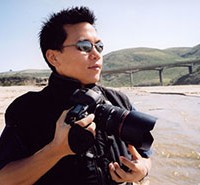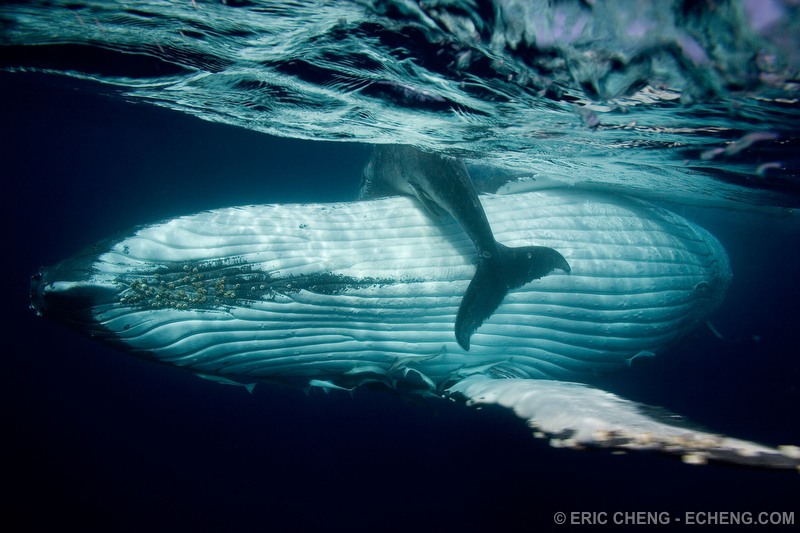
I’ve always had a huge fascination with marine life, so when I had a chance to interview a photographer that specializes in a unique genre, I immediately went after Eric Cheng, an underwater photographer based out of San Francisco. Shooting underwater since 2001, Eric is the winner of numerous awards and competitions, founder of an online community for underwater photographers, editor of a quarterly print magazine, and frequently organizes photography expeditions and workshops across the planet. He even has two degrees in computer science from Stanford and plays the cello. Talk about chick magnet. Unfortunately, the only chick he has time for these days is a 14-foot long Bahamian tiger shark named Emma.
SA: How did you get started in underwater photography?
EC: Although I have been interested in photography since high school, I was 25 years old when I discovered underwater photography. When I was 19 years old, I started a saltwater reef aquarium, which instilled a fascination within me for fish and other marine life. I became SCUBA certified not long after, but only did about 20 dives in the next six years. On a whim, I planned a dive trip to Palau—my first dive trip ever—and bought an Ikelite underwater housing for my Nikon Coolpix 990 digital camera. I was hooked – my interests in marine life and photography merged and changed my life!
SA: How much time do you spend on a boat these days? What’s a typical day in the life of an underwater photographer while on assignment?
EC: I spend about half of my time on boats. It’s funny – everyone thinks that I am “on vacation” all the time, but a typical day on assignment is long and tiring. We do between three and five dives a day, and with a surface interval between each dive, it pretty much takes up all of the hours between morning and evening. And because everyone now shoots using digital cameras, a great deal of time is spent downloading, backing up, organizing and editing. Still, it’s fun. At home, I’m constantly connected to the computers and the internet. Underwater photography takes me to some of the most remote locations on the planet; there is no internet access there, so the pace of life slows down, even with such a busy schedule.
SA: How different is underwater photography compared to another genre, such as landscape photography?
EC: In some ways, they are similar. Both genres require a connection to nature – an understanding that we are there to capture what nature might throw our way, and that it might take quite a bit of time for a particular event to happen. But underwater photographers immerse themselves into an incredibly harsh environment, one that is often filled with adrenaline and fast-moving spectacle. On a daily basis, underwater photographers deal with getting thrown around on the surface of the ocean before jumping into the same, rough ocean and being swept away by strong currents. Almost every reef animal in the ocean is venomous, and the ones that aren’t venomous are all trying to get away from us. We bring our own lighting underwater because light gets stripped away by water as it travels through it, but even with large, heavy strobes, a subject that is six feet from the camera is still too far away.
SA: What do you like the most about shooting underwater?
EC: Discovery. Despite its majority coverage on our planet, we really don’t know much about the ocean. I like that someone can do the same dive every day for years and still have a good chance of seeing something new.
SA: I’ve seen some of your shark photos. Is photographing sharks frightening or exciting, or perhaps both? Do you have any crazy shark stories?
EC: Remember how I said that nearly all of my best photos were taken within six feet of the subject? For sharks, it’s even closer. Most were taken within just a few feet.
Last week, I stuck a little GoPro helmet-cam into a shark’s mouth so I could get footage from inside. The footage looks scary, but that shark was only after the tiny bit of fish I used to entice it. If humans were a shark prey item, there would be many more than the five (average) killed each year (and in most cases, they aren’t eaten).
I do have some “crazy” shark stories. Here’s one. The most famous tiger shark in the world is named Emma. She lives in the Bahamas and is 12-14 feet long, depending on who you ask. I’ve been photographing her for nearly five years and can identify her by her markings and behavior. I’ve seen Emma get pregnant and slim down after giving birth, twice. Emma treats different individuals differently: she has favourites. Can you imagine that? She’ll come in and look for Jim, the captain of the boat, and will leave if he isn’t in the water. If he is in the water, she’ll stay, for days. Each encounter with Emma is special because it could be the last; tiger sharks are allowed to be killed in the Bahamas by recreational anglers. It would be tragic if Emma were killed, not only because of the bond we have formed with her, but because it would cost the Bahamas tens of thousands of dollars a year in lost tourism.
SA: The types of camera equipment you use in underwater photography must be completely different from most photographers’ kits. What pieces of gear are the most crucial to your line of work?
EC: All of the pieces of gear are the most crucial. Packing is an ordeal because I have hundreds of tiny little parts that have to go together in order for my gear to work properly. If even one doesn’t work, some critical feature of my camera or life-support equipment will no longer be available. Obviously, the most important ones are the o-rings, which seal the camera up to prevent water from getting inside. But other little parts allow access to the physical buttons on my camera and strobes. Also, electrical systems on boats tend to be quite primitive, so I travel with as many redundant parts as I can: spare chargers, spare batteries, spare cables, spare strobes, spare camera, etc.
Assuming all of the gear arrives undamaged, the most crucial skill is simply diving skill. Excellent buoyancy and body control in the water are absolute requirements for good underwater photography. If you’re crashing into the reef or thrashing around in place in order to stay in one place, you have little hope of capturing a great image.
SA: Underwater photography has taken you to many different ocean environments around the world. What place (or places) is the most memorable to you? Can you tell us a little about it?
EC: I get asked this question all the time, and I never have a proper answer. Each place I go has something special that I am after, and there is no way to rank them! For example, I go to Indonesia, Papua New Guinea, and the Solomon Islands for marine diversity and healthy reefs; to the Bahamas, Galapagos, Cocos, and French Polynesia for sharks; to Dominica, Ogasawara (Japan), and Tonga for whales. It’s too hard to pick one that is the most memorable.
SA: You’re editor of a couple of important resources for underwater photographers. Can you tell us about them?
EC: Wetpixel.com is the premiere online community for underwater photographers and videographers. I’ve been running this site since 2001, and it has become incredibly rewarding to be a part of the community. Many underwater photographers find themselves to be the only person in their town or city with the interest, and Wetpixel is a place where they can go to find peers.
Wetpixel Quarterly is a quarterly print magazine featuring the best in underwater photography. I call it a “magazine,” but it is really a mini-coffee table book. It is universally acclaimed by marine enthusiasts because we put in beautiful, compelling images instead of images that will sell advertising. Unfortunately, print seems to be going away, and we are in the process of figuring out how to keep a print product without breaking the bank.
SA: It seems that a lot of underwater photographers are also quite passionate about marine conservation. How important is photography to the success of ecological conservation?
EC: I’d like to think that photography is very important to the success of marine conservation. The vast majority of people on this planet will probably never set foot in the ocean. I live in coastal California, and most of my friends here have never done more than dip their feet. People are fascinated by it—and afraid—and no one really cares about what happens to the ocean because it’s just not a part of their everyday lives. Still, many of the people who have seen my images have written to say that it has made them think about ocean differently, and that pushes me to continue to share my work. But I still see them eating shrimp, so that makes it hard for me to be optimistic in the long term.
SA: What kind of advice can you give someone that’s looking to pursue a career in underwater photography? Other than moving to the beach, of course!
EC: I don’t really have any advice for people who want to pursue underwater photography as a career. It’s nearly impossible to do, and many folks out there who are frequently published struggle to make a living at it. Startup costs are extremely high, and if you start out in a dive-related industry, you’ll probably never make enough money to buy a decent underwater photography rig.
I always recommend getting a proper education. Study something useful and practical; hopefully, something you’re also interested in. Make enough money to buy a camera, lenses, underwater housing, strobes, and accessories, and start shooting in your spare time. Publish your work: post it on the web, and to sites like Wetpixel. If you’re good, you’ll get noticed, and opportunities will come to you!
Thanks to Eric for sharing his stories and bringing us into his vast underwater world of photography! Be sure to browse through more of his photos or visit www.echeng.com to learn more about Eric and his work.
Eric’s Gear:
- Canon 5D Mark II
- Canon 7D
- Nauticam underwater housing
- Ikelite and INON strobes
- Light & Motion underwater lights
- BS Kinetics 3D underwater video housing
- Tokina 10-17mm fisheye zoom
- Canon 15mm/2.8 fisheye
- Sigma 20mm/1.8 prime
- Canon EF-S 60mm macro
- Canon 100mm macro
- Kenko 1.4x, 2.0x teleconverters
- INON “insect eye” endoscopic lens







